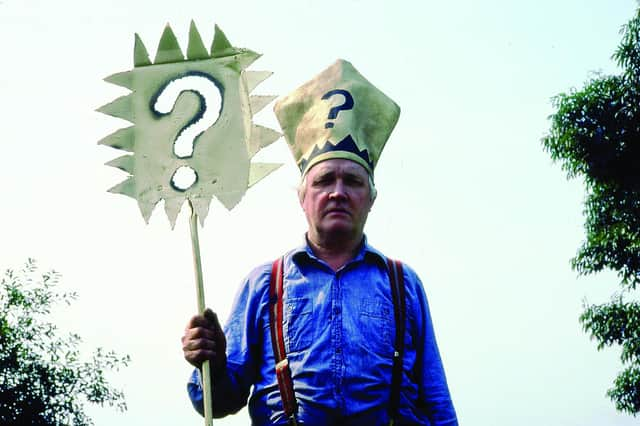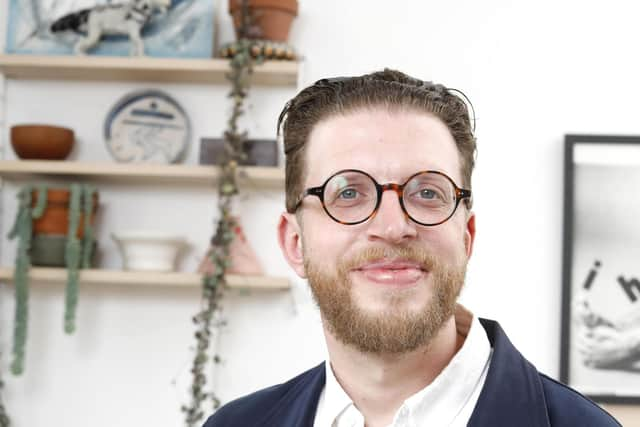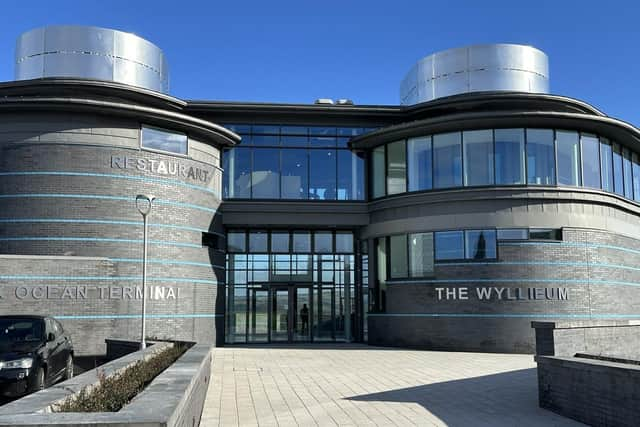Wyllieum director Will Cooper: 'There's a lot more to George Wyllie than any of us know’


It’s rare for a day to go past when I don’t get a knock on my office window from a Greenock resident ready to proudly share their experiences of knowing George Wyllie, and more often than not, also listing the various artworks that George gave to them that still sit pretty in their home. This engagement is testament to the place that George Wyllie occupies in the hearts and minds of so many in Inverclyde.
Before becoming the inaugural director of The Wyllieum, I have had the pleasure of working in a wide range of museums and galleries across the UK. From Bath’s Holburne Museum to Glasgow’s Gallery of Modern Art, from the hallowed halls of Tate Britain to Gateshead’s BALTIC Centre for Contemporary Art, my career has taken me all over the place. Nowhere I have been met with such broad enthusiasm for contemporary visual art than I have here in Greenock. There’s something about George Wyllie that people just get. Once open, The Wyllieum will become the new home for the work and ideas of George Wyllie, we will show the biggest collection of his work anywhere in the world, alongside a rolling programme of changing temporary exhibitions.
Advertisement
Hide AdPrior to joining the organisation, I thought I knew most of what there was to know about George; the cheeky, “untrained”, artist who made stuff out of bits “borrowed” from the heavy industry that once occupied the Clyde. I knew The Paperboat and The Straw Locomotive, I’d read about A Day Down The Goldmine and smiled at The Tartan Bicycle in Glasgow Museums’ storage units.


But what the last year or so employed as the director of The Wyllieum has taught me is that none of us know the full picture. None of us have been given the chance to see the incredible range of materials, subjects, and ideas that occupied George and that he made from steel, stone, feathers, paper, and god knows what else. There is a lot more to George than any of us realise.
It is because of this lack of knowledge that I’m bursting with excitement to welcome the first visitors to The Wyllieum on Greenock’s waterfront when we open doors on 26 April. Yes, you’ll be able to see many of George’s more famous works, but never has an organisation spent so long developing a programme that will fully probe and explore every aspect of his output. From sculptures to drawings, and performances to poems, The Wyllieum will be the home for all of it.
Born in Glasgow in 1921, George trained as an engineer with the Post Office before serving in the Royal Navy from 1942 to 1946. After this and back in Inverclyde he worked as a Customs and Excise Officer for nearly 30 years before retiring and becoming a full-time artist in his late 50s. From here he pioneered a socially engaged practice that resulted in artworks such as the Straw Locomotive, which hung over an empty Clyde as a requiem for Glasgow's engineering prowess; and The Paper Boat, a reminder that over two fifths of the world's merchant ships were once launched on the Clyde.
Many of George’s major works have become even more prescient over time. The aforementioned Straw Locomotive and Paper Boat communicated the hole left in communities after industry was ripped from them in the 1980s. He also built sculptures that depict a home buckling under the pressure of its mortgage, and he wrote plays including A Day Down A Goldmine, first performed at Glasgow’s Tramway, The Whitworth in Manchester, and London’s Institute of Contemporary Arts. The original production starred George alongside Bill Paterson in a story chronicling the origins of the modern banking system and its inherent inequalities.


George’s sense of equality and social justice was formed, in no small part, by his experiences as a younger man. The socialist principles of shipbuilders, dockworkers and the river economy were compounded by his experiences during the Second World War; serving in the Royal Navy, George was one of the first foreign nationals to visit Hiroshima shortly after America dropped the atomic bomb. The violence and sense of a world out of balance remained with him for the rest of his life.
Advertisement
Hide AdBy the 1970s George had retired as a customs and excise worker in order to focus entirely on art. A friendship with renowned Edinburgh based gallerist Richard Demarco led to exhibitions across Scotland and horizon expanding meetings with other creative figures including the groundbreaking German artist Joseph Beuys. The influence of Beuys can be clearly seen in so many of George’s works and will be expanded upon across The Wyllieum’s future programme.
It was during this time that George also met Barbara Gregor, the chair of The Scottish Sculpture Trust, and her husband the renowned filmmaker Murray Grigor. Grigor’s influential film about George, The Wh?sman, will be on view in the Wyllieum. Their ongoing influence and support was hugely important for George as his career as an artist progressed. The Wyllieum would not exist without the years of support from Murray, we are indebted to his generosity and spirit.
Advertisement
Hide AdIt is testament to the quality of George’s work – some made nearly 50 years ago – that it remains as pertinent, poignant and progressive today as it did when it was made. Hanging above my desk as I write this is a drawing George made lamenting the perils of North American First People after the invasion of European settler-colonists. George made the work in the early 1980s, long before most other European artists were considering their place in a post-colonial world.
The HMS Discrete, a steel submarine adorned with a garland of lights, critiques the modern military industrial complex and mocks the idea that the nuclear submarines visible from The Wyllieum en route to Faslane are a benign, comforting addition to the Clyde. George saw through this codswallop, telling us in simple terms that nuclear deterrents are no form of comfort.
George’s pacifist tendencies are rooted in his desire to find balance in his life after serving in the Second World War. He called this his “search for equilibrium” and it is articulated perfectly in his series, Spires. These sculptures are the focus of our first temporary exhibition George Wyllie: Spires, curated by the brilliant artist Sara Barker and me.
First appearing in George’s ground-breaking live work, A Day Down A Goldmine, these simple sculptural forms are the culmination of his development as an artist of merit. Drawing on his experiences on the Clyde (see their similarities to the poking masts of ships) and finessed through his friendships with artists George Rickey and Joseph Beuys, his Spires mark a transformative moment in his practice where a material language and a clear conceptual rigour successfully meet.
Their simple form – a three-legged base with a vertical pole, held in balance by a rock or stone – can be seen as the culmination of a lifetime’s practice, and draw inspiration from George’s full and varied life.
The tepee (similarly constructed from three simple, vertical poles) popularised by North American First People was well known to George, and its form began to appear in his work while staying with George Rickey in his Massachusetts studio Hand Hollow. The strong vertical form and gimble used to create balance are borrowed from his deep love of all things maritime. Their ability to sway and move in the wind creates a simple rhythm reminiscent of a flag, sail, or ship’s mast.
Advertisement
Hide AdOver time, George’s Spires became akin to monuments. Simple works used to mark a specific time or place. However, unlike the traditional sculpted monument depicting a political hero or person of military significance, the Spires were designed to celebrate “wherever they stood”. This simple, rebellious act dismantled the need to find heroes in our public life, instead allowing the user of these works to memorialise whatever we each value.
In this light, George produced Spires to celebrate his wife Daphne, to mark his good friend Beuys’ favourite place in Scotland (Rannoch Moor), or to embellish his garden studio (Studio Spire). The two portable spires included in this exhibition lived in the back of George’s car, ensuring they were never far from his grasp should something need memorialising. In his own words:
Advertisement
Hide AdThe Spire is designed to celebrate the place on which it stands. Beyond that, its importance is of no importance. It can define any space or presence taken for granted and signify them important.
For George, the Spire was a vital artwork. They allowed him to celebrate the everyday, mundane and happenstance. They remove pomp and ceremony, instead opting to focus our attention on our everyday interactions with places, people, and events. What better way to celebrate the opening of the Wyllieum than with a similar celebration of our beautifully normal lives.
The Wylleum will open to the public on 26 April, see www.wyllieum.com
Comments
Want to join the conversation? Please or to comment on this article.